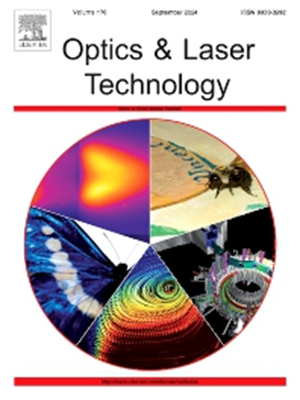Effect of graphene nanoflakes on the hydrogen embrittlement behavior of laser powder bed fusion formed titanium matrix composites
IF 4.6
2区 物理与天体物理
Q1 OPTICS
引用次数: 0
Abstract
The Ti-6Al-4 V alloy produced by laser powder bed fusion (LPBF) is one of the most typical titanium (Ti) alloys, combining the characteristics of α-Ti and β-Ti. Due to its low density, high strength, good toughness, and biocompatibility, it is widely used in fields such as aerospace, high-speed trains, and medical implants. However, its specific microstructure is sensitive to hydrogen absorption and embrittlement, which limits its broader application. This paper investigates the effects of doped graphene nanoflakes (GNFs) on the microstructure and hydrogen embrittlement (HE) resistance of LPBF-formed titanium matrix composites (TMCs) through microscopic characterization and slow strain rate tensile testing with electrochemical hydrogen pre-charging. The results indicate that the presence of hydrogen atoms adversely affects both the strength and plasticity of the composites with varying graphene content, with increased sensitivity to HE as the graphene content rises. The strength loss rates for composites with 0 wt%, 0.1 wt%, and 0.2 wt% GNFs are 7.29 %, 4.84 %, and 19.23 %, respectively, while the plasticity loss rates are 51.70 %, 59.91 %, and 60.57 %. The fracture mode is primarily a mixed ductile–brittle fracture, with the crack initiation and propagation mechanisms transitioning from transgranular fracture to intergranular fracture. These findings provide a theoretical basis and technical support for the engineering application of LPBF-formed TMCs in hydrogen-rich service environments.

求助全文
约1分钟内获得全文
求助全文
来源期刊
CiteScore
8.50
自引率
10.00%
发文量
1060
审稿时长
3.4 months
期刊介绍:
Optics & Laser Technology aims to provide a vehicle for the publication of a broad range of high quality research and review papers in those fields of scientific and engineering research appertaining to the development and application of the technology of optics and lasers. Papers describing original work in these areas are submitted to rigorous refereeing prior to acceptance for publication.
The scope of Optics & Laser Technology encompasses, but is not restricted to, the following areas:
•development in all types of lasers
•developments in optoelectronic devices and photonics
•developments in new photonics and optical concepts
•developments in conventional optics, optical instruments and components
•techniques of optical metrology, including interferometry and optical fibre sensors
•LIDAR and other non-contact optical measurement techniques, including optical methods in heat and fluid flow
•applications of lasers to materials processing, optical NDT display (including holography) and optical communication
•research and development in the field of laser safety including studies of hazards resulting from the applications of lasers (laser safety, hazards of laser fume)
•developments in optical computing and optical information processing
•developments in new optical materials
•developments in new optical characterization methods and techniques
•developments in quantum optics
•developments in light assisted micro and nanofabrication methods and techniques
•developments in nanophotonics and biophotonics
•developments in imaging processing and systems

 求助内容:
求助内容: 应助结果提醒方式:
应助结果提醒方式:


